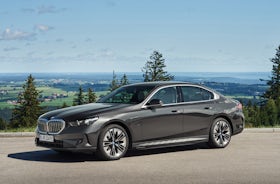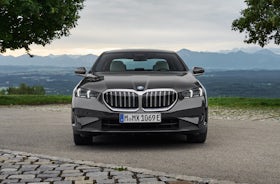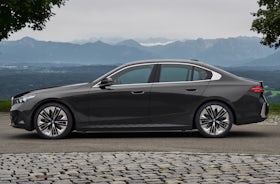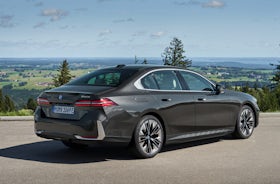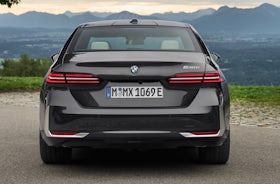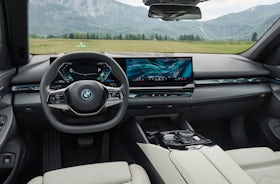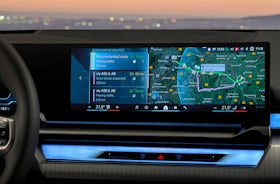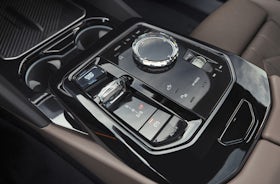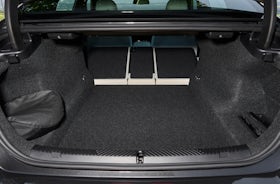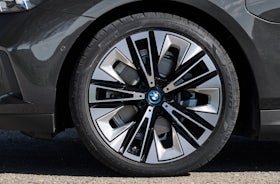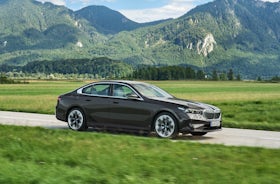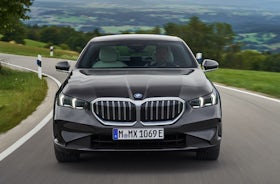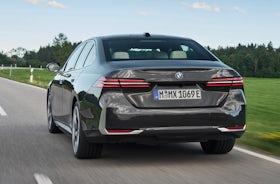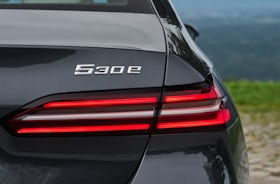BMW 5 Series Review & Prices
The BMW 5 Series is an upmarket saloon with a lovely cabin, but it’s not quite as good to drive as its alternatives
- Cash
- £48,135
- Monthly
- £535*
- Used
- £35,023
What's good
What's not so good
Find out more about the BMW 5 Series
Is the BMW 5 Series a good car?
Think of an all-rounder, and two things are likely to spring to mind. First will be a Swiss army knife – the global icon for ‘a thing that does everything’ – and the next could well be the BMW 5 Series.
Since debuting five decades ago, this posh German saloon has proven time and again that it can offer comfort, bags of practicality, the latest technology and serious performance. It’s a similar story with its two key alternatives – if you’re considering a 5 Series you should also take a look at the Mercedes E-Class and Audi A6. Or perhaps the Lexus ES if you want a left-field option.
The latest 5 Series clearly takes hints from BMW’s recent bold design direction as seen on the likes of the 2 Series Coupe and XM, albeit a little more subdued. That said, its styling is rather challenging, lacking the elegance of its predecessors. There are odd, incohesive lines around the headlights and front bumper, a front grille that seemingly mimics beaver teeth and the rear end looks like the designers couldn’t agree on what to do so gave up halfway through the process.
Watch: All-electric BMW i5 review
It’s a different story inside, with BMW’s latest infotainment system present and correct, combining a 12.3-inch digital drivers’ display with a 14.9-inch central screen. Apple CarPlay and Android Auto are included as standard, and operate wirelessly.
The overall design is pretty good and although some of the physical buttons have disappeared, forcing you to use the touchscreen more, there are high quality materials and solid build quality to make up for it. Artificial leather upholstery comes as standard, though you can opt for the real stuff, as well as a part-Alcantara choice if you’d prefer.
So you get all the good tech, but if practicality is key, you might be a touch disappointed. Petrol-powered versions of the new 5 Series promise 520 litres of boot capacity, which is less than the Mercedes E-Class and Audi A6, though not by much. On the plus side, unlike those two cars the BMW’s boot doesn’t lose capacity in the plug-in hybrid version. A Touring estate version will arrive later if you need the extra room.
The BMW 5 Series is available with one petrol engine, offering 208hp, and a pair of plug-in hybrid versions with up to 489hp. Notably, there’s no diesel version, which is a sign of the times given that this model is typically popular with those who rack up serious motorway mileage.
The BMW 5 Series is comfortable to drive and has a lovely interior – shame the outside just looks so… bleugh
It’s goodbye to diesel, but hello to electric for the first time in a 5 Series. The i5 – reviewed separately here – will do up to 361 miles on a charge, but is quite a bit more expensive than the petrol-powered model.
As you might expect, the BMW 5 Series is a comfortable and refined motorway cruiser. There’s a little bit of wind and road noise but overall it’s a relaxing way to rack up miles. However, BMWs usually excel at also being great fun on a twisty road, but the latest 5 Series is a bit disappointing in this regard. The steering is numb and doesn’t give much feedback about how much grip the tyres have, while the car just generally lacks the eagerness to turn into a corner that made old versions so much fun to drive. An Audi A6 is, surprisingly, more fun here…
Regardless, this is a great all-rounder and just a fraction better overall than the Mercedes E-Class and Audi A6. Want one? Check out the latest BMW 5 Series deals available through Carwow. You can also see how much you could save on a used 5 Series from our network of trusted dealers, as well as other used BMWs. You can sell your car through Carwow, too.
How much is the BMW 5 Series?
The BMW 5 Series has a RRP range of £52,195 to £88,015. However, with Carwow you can save on average £6,739. Prices start at £48,135 if paying cash. Monthly payments start at £535. The price of a used BMW 5 Series on Carwow starts at £35,023.
Our most popular versions of the BMW 5 Series are:
| Model version | Carwow price from | |
|---|---|---|
| 520i M Sport 4dr Auto | £48,135 | Compare offers |
The BMW 5 Series starts at just over £50,000 for the petrol-powered 520i. This quickly rises to almost £60,000 for the 530e plug-in hybrid, or over £76,000 for the more powerful 550e. All start with the M Sport trim, but for an extra £3,000 can be upgraded to M Sport Pro, bringing larger 20-inch alloy wheels, gloss black styling touches, and an illuminated front grille surround.
To give you some context, that’s marginally more affordable than the Mercedes E-Class, which starts at £55,000 but in its most powerful, top-spec, plug-in hybrid guise will set you back over £85,000. The Audi A6 is generally cheaper, starting around £45,000 and rising to nearly £70,000, but it is showing its age now.
It’s worth noting that the all-electric BMW i5 starts around the same price as the 550e plug-in hybrid, making the electric version particularly enticing for company car buyers who will see ultra-low benefit-in kind rates. In M60 trim the i5 starts at just under £100,000 though, which feels like a lot of money for a 5 Series…
Performance and drive comfort
The BMW 5 Series is quiet and refined for long motorway drives, but not as fun as you would expect a BMW to be in the corners
In town
The BMW 5 Series is pretty easy to drive around town because the steering is light and there’s good visibility all around. It can feel pretty big on particularly tight streets, but you do get a 360-degree camera as standard to help you judge the car’s extremities.
The 520i isn’t particularly powerful, but it’s got enough grunt for pootling around town, and the gearbox is quick-witted enough to let you take advantage of gaps in traffic. However, one of the plug-in hybrids will be better-suited here because you can glide around silently on electric power.
Comfort is impressive, too. It doesn’t glide across surfaces with the refinement of the E-Class, but there’s really not much in it. You just feel a few sharper bumps such as potholes more than you would in the Mercedes.
On the motorway
While there’s a hint of sportiness in the way you feel the odd lump and bump in the road at slower speeds, it’s not as noticeable at motorway speeds. There’s a small amount of wind and tyre noise, but you’d have to be incredibly picky to complain about it. Again, the Mercedes E-Class feels a bit more luxurious on a long drive, but the difference isn’t huge.
Rather disappointingly, you only get regular cruise control as standard, with adaptive cruise control being part of the Technology Plus Pack, which also adds a head-up display to help you keep your eyes on the road ahead.
On a twisty road
BMW has a reputation for making comfy, upmarket cars that are also great fun when you find yourself on a twisty stretch of Tarmac. However, the latest 5 Series lets the side down a bit. For a start, the steering is rather numb, so you don’t get much feedback about how much grip you have. Related to this, the car doesn’t feel particularly keen to turn in unless you really chuck it about, but even then you don’t have much confidence in the car holding onto the road. The 520i lacks the power to accelerate quickly out of corners, too.
The result is that, while the car is composed on a twisty road – the body doesn’t wobble about when you turn and the suspension soaks up bumps nicely – it never puts a big smile on your face. Surprisingly, an Audi A6 is actually more enjoyable. Audis have a reputation for being safe and reliable more than fun, but the A6 is more responsive to your steering inputs and feels more agile in turns than the 5 Series. Quattro models have excellent all-wheel drive grip, too.
Space and practicality
Passengers will find the 5 Series roomy inside, but there’s not as much storage as alternatives
Drop into the front seats of the BMW 5 Series and you’ll find it’s plenty spacious enough, and there’s a lot of adjustability in the driver’s seat and steering wheel to get comfortable, even for taller drivers.
Storage up front is decent, with door bins that are big enough for a large bottle of water, while in the middle is a pair of cupholders and a wireless phone charging pad for two phones beneath the dashboard. The armrest has some extra space inside, and it has a split opening so the driver or passenger can easily access it. Useful storage, then – but there are more and bigger cubby holes in both the Audi A6 and Mercedes E-Class.
You can plug two phones directly into the car with two USB-C slots up front, and there’s a 12V socket, too.
Space in the back seats
Space in the back is really good, with loads of legroom and headroom. However, while you can fit your feet under the seat in front, there’s not a huge amount of space down there. At least the wide body means you can fit three across the back a bit more easily than in the A6 and E-Class, while the middle-seat passenger has a comfy cushion, too.
Storage is again only so-so. It’s odd that there are no map pockets in the back of the front seats, and the door bins are okay – you can comfortably fit a couple of small water bottles inside. There’s another small storage compartment between the front seats, and there are two cupholders in the centre armrest. A useful addition is a USB-C slot in the back of each of the front seats, so there’s no arguing over who gets to charge their iPad…
Boot space
At 520 litres, the BMW 5 Series has a pretty big boot, though it is the smallest out of its key alternatives, with the Mercedes E-Class getting 540 litres and the Audi A6 having 530 litres. There’s not a great deal in it then, and all should have enough space for most people.
Where the BMW does have an advantage is that there’s no space penalty for the plug-in hybrid, which has the same 520-litre capacity. The Audi and Mercedes both drop to a measly 360 litres in hybrid form.
There’s no load lip to lift heavy items over and the space is a useful square shape so it’s not too tricky to pack lots of items in. However, the saloon body style means the opening isn’t particularly big, so bulky items can be rather awkward to fit inside.
Interior style, infotainment and accessories
Well-built with quality materials throughout, though the infotainment isn’t the easiest to use
While the exterior design might be rather challenging, no such complaint can be thrown at the interior. It’s dominated by that huge curved twin-screen setup that sits on the dashboard, which has allowed most of the physical buttons to be removed and their functions inserted into the infotainment screen.
That’s not ideal, because although the likes of the climate settings are always visible at the bottom of the display, it’s not as intuitive to use on the move as a bank of physical switches. It’s a similar story with the rest of the infotainment setup. The main screen is huge at 14.9 inches, with crystal clear graphics and it’s very quick to respond to your touch, but there are so many settings and menus it can be difficult to navigate your way around them. At least there’s a rotary dial beside you that can make it easier to change settings while you drive.
It’s not quite as visually impressive as the optional triple-screen setup in a Mercedes E-Class, but largely works a bit better. For example, Apple CarPlay and Android Auto connect seamlessly and use up the whole screen, unlike in the Mercedes. Furthermore, your phone maps also show in the 12.3-inch digital instrument display that’s behind the wheel, which is an excellent feature you don’t see very often.
Away from the tech, the 5 Series interior is generally high quality, with squishy plastics in all the important places and a feeling of solidity. It maybe doesn’t quite have the pizazz of the E-Class, and like that car there are a few bits that feel rather cheap considering the price. However, both feel plush and high-tech compared with the ageing Audi A6.
MPG, emissions and tax
The BMW 5 Series range opens with the 520i, which uses a 208hp petrol engine and sees fuel economy of up to 48.7mpg in official tests. If you’re looking for the most affordable all-rounder as a private buyer, it’s probably your best bet.
However, there’s also a pair of plug-in hybrid engines, both of which are available with either rear-wheel drive or all-wheel drive. The 530e makes 299hp, while the pricier 550e makes a healthy 489hp. If economy is your focus then go for the 530e, largely because it has less power so should be a bit more efficient. It also has a slightly longer electric-only range of up to 63 miles, compared with the 550e’s 56 miles. Having impressive electric range contributes to wild fuel economy figures of up to 470mpg in official tests, but you will only hit these sorts of numbers if you keep the battery regularly topped up and do shorter journeys. Something like 60mpg is probably more realistic, but we’ll put this to the test soon…
For company car buyers who want a combustion-engined 5 Series, these hybrids will be your best bet thanks to the lower Benefit-in-Kind rate than the petrol. However, as an electric car, the i5 has a rock bottom company car tax rate that makes it all the more appealing. Hybrids also have lower car tax than petrols, while electric cars pay no Vehicle Excise Duty at all.
Safety and security
The BMW 5 Series scored the full five stars in Euro NCAP safety testing, with impressive scores across the board. It was rated 89% for adult occupant protection, 85% for child occupants, 86% for vulnerable road users, and 78% for its safety tech.
Standard assistance kit includes cruise control, lane-keeping and a system that will park the car for you. You can also pay extra for the Technology Plus Pack, which includes adaptive cruise control with a stop and go function in slow-moving traffic, as well as a warning to help avoid cyclists and pedestrians.
Reliability and problems
This generation of BMW 5 Series isn’t old enough to get a clear picture of its reliability. BMW doesn’t have a brilliant reputation for reliability, though it’s far from the worst, and the outgoing 5 Series was known for largely avoiding issues.
All new BMWs come with a three-year, unlimited mileage warranty. However, if reliability is a key concern, Lexus has a fantastic reputation, and its warranty can be extended up to 10 years with annual servicing.
- Cash
- £48,135
- Monthly
- £535*
- Used
- £35,023
Configure your own 5 Series on Carwow
Save on average £6,739 off RRP
Popular BMW 5 Series colours
Popular BMW car types
*Please contact the dealer for a personalised quote, including terms and conditions. Quote is subject to dealer requirements, including status and availability. Illustrations are based on personal contract hire, 9 month upfront fee, 48 month term and 8000 miles annually, VAT included.


